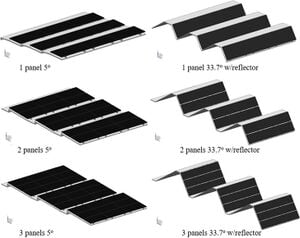
Relentless cost declines in solar photovoltaic (PV) modules have radically reduced system costs, but the result is that racking costs have become more important. In this study a new open source racking method using earth and shotcrete-based ground mounts is investigated in two geographic regions: (1) Boa Vista, Brazil, where PV rows have an optimized shallow tilt angle and can be close-packed and (2) Kingston, Canada, where racks can make use of low concentration in the required inter-row spacing. Models are developed for both locations with single, double and triple vertical stacked shotcrete-based ground-mounted PV racking systems. Using these models bills of materials and energy simulations are produced to provide a cost benefit analysis specifically for the shotcrete racks. The results show that for utility-scale PV systems near the equator, a shotcrete racking system could reduce racking costs by 18–22% from the least expensive conventional racking and as much as 47% reduction for more expensive commercial racking. Economics is less clear for shotcrete-based racking at higher latitudes that incorporate low-concentration reflectors as they can be both lower and higher costs than conventional racking, but would be expected to produce at least 18% more electricity per installed Watt. Overall this novel racking concept was found to be promising, particularly for desert regions where it could reduce soiling losses. The results of this study indicate a need for future work to fully evaluate the potential of shotcrete racking to reduce solar electricity costs at the utility scale.
Highlights[edit | edit source]
- Open source PV racking to reduce cost in utility scale ground mount systems.
- Modules fastened to graded land covered in shotcrete with basic mounting hardware.
- Open source V-shaped design, bill of materials, and cost comparison.
- Northern latitude with low concentration reflector and equator designs.
- Racking costs reduced 18–22% at low latitudes.
Keywords[edit | edit source]
Low concentration, Ground mount, Racking, Utility solar, Sustainable development; Open-source; Photovoltaic
See also[edit | edit source]
- Photovoltaic System Performance Enhancement With Non-Tracking Planar Concentrators: Experimental Results and Bi-Directional Reflectance Function (BDRF) Based Modelling
- Photovoltaic system performance enhancement with non-tracking planar concentrators: Experimental results and BDRF based modelling
- Low level concentration for PV applications
- Effects of low concentration planer concentrators on array-scale solar photovoltaic systems performance
- Total U.S. cost evaluation of low-weight tension-based photovoltaic flat-roof mounted racking
- Design of Post-Consumer Modification of Standard Solar Modules to Form Large-Area Building-Integrated Photovoltaic Roof Slates
- Distributed manufacturing of after market flexible floating photovoltaic modules
- Zytech - doing LCPV
- Open source DIY solar photovoltaic racking
- Impacts of Location on Designs and Economics of DIY Low-Cost Fixed-Tilt Open Source Wood Solar Photovoltaic Racking





